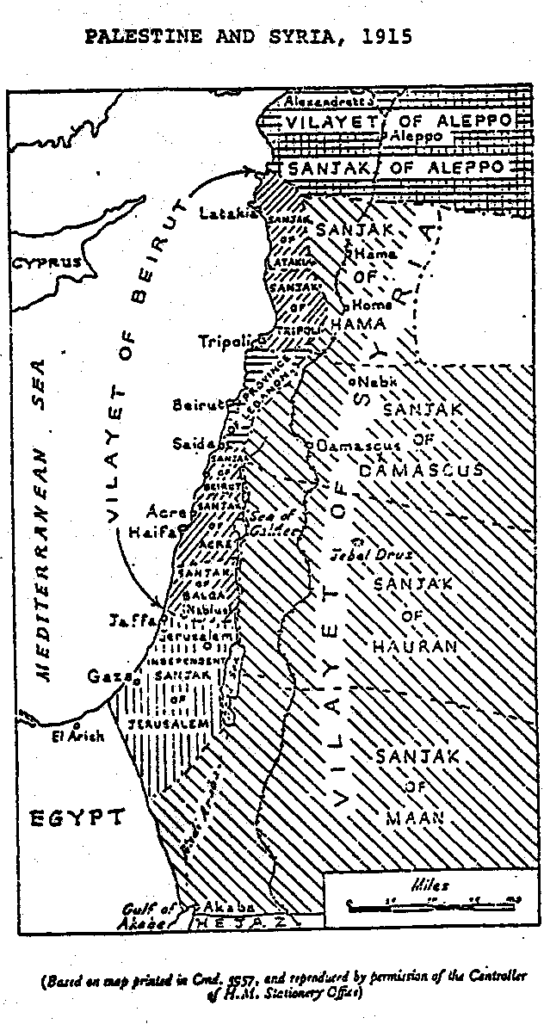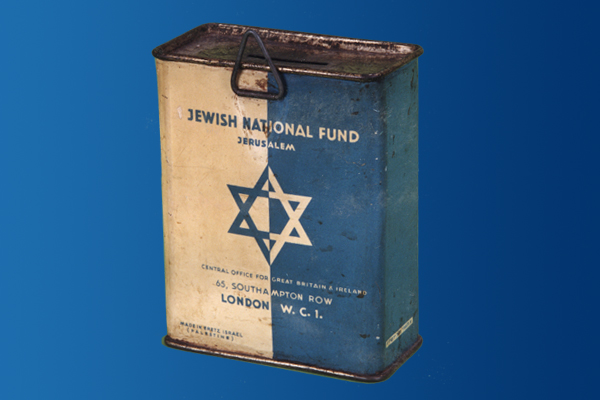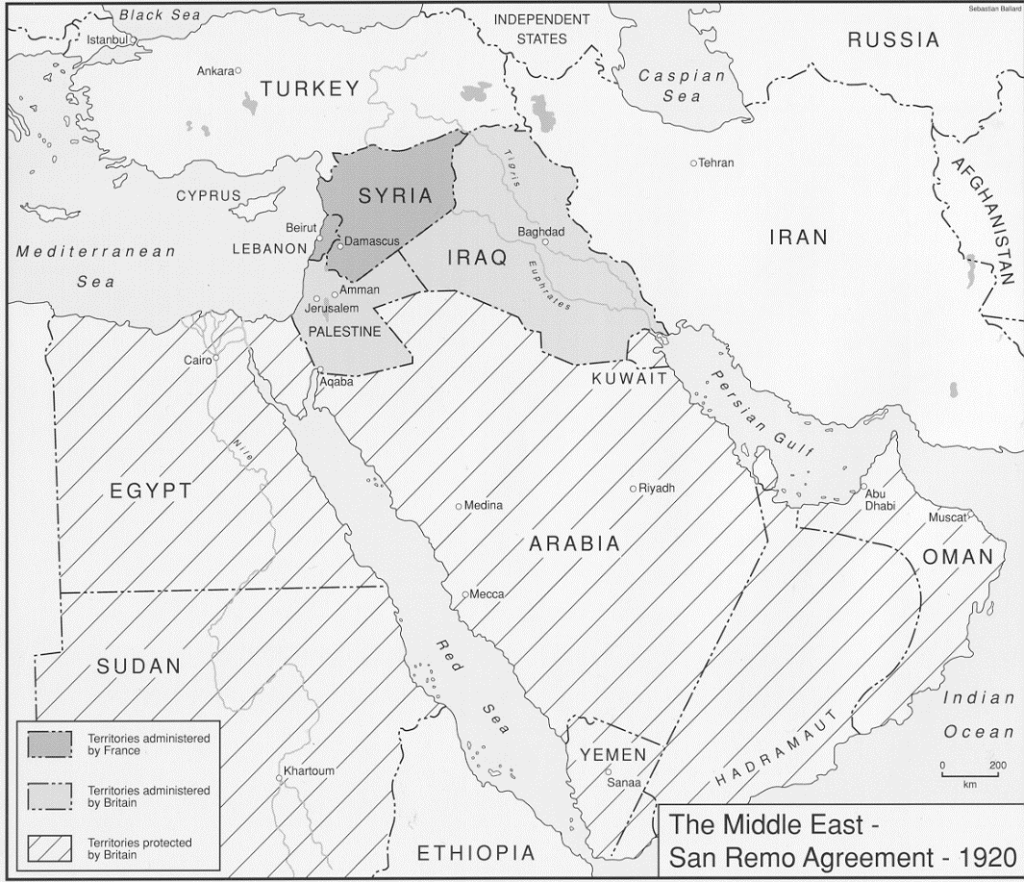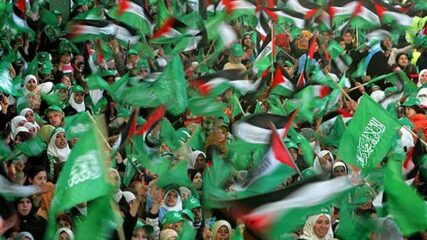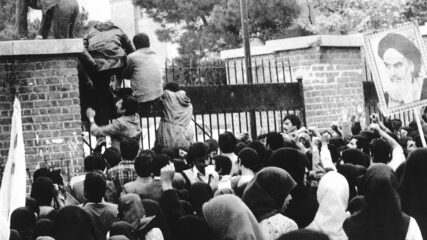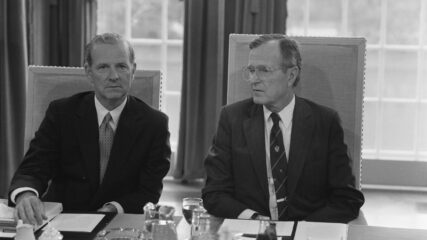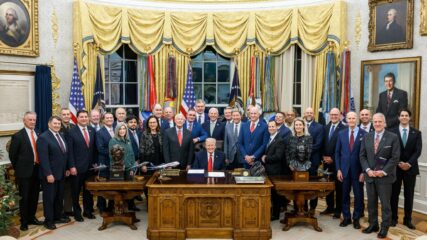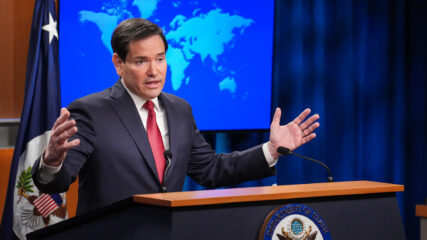Updated November 21, 2025
Originally posted in 2018.
Selected and abbreviated by Emory Emeritus Professor Dr. Kenneth Stein and Michael Jacobs
- To 1800s — Jews retain historical link to the land of Israel; biblical covenants and Jewish peoplehood sustains Jewish identity in diaspora; episodic but regular and violent anti-Semitic outbursts contributes to common Jewish experiences. Failure to gain civic equality or citizenship rights and restrictions placed upon where Jews could live, have access to the professions, and gnawing poverty for others, forces many Jews to consider emigration, conversion, assimilation, or alternative religious practice- reform and conservative Jewish ideals. A very small number of Jews choose the amorphous idea of establishing a Jewish place of their own- Zionism emerges.
- 19th century — Area of ancient Israel not an independent state or political entity and will not be until 1920.
- 1882 — First Aliyah of Jews returning to settle in the Land of Israel.
- 1884-1896 — The trial and erroneous conviction of Jewish French Capt. Alfred Dreyfus push Theodor Herzl to write The Jewish State, emphasizing the need for Jews to free themselves from antisemitism by having a modern state of their own.
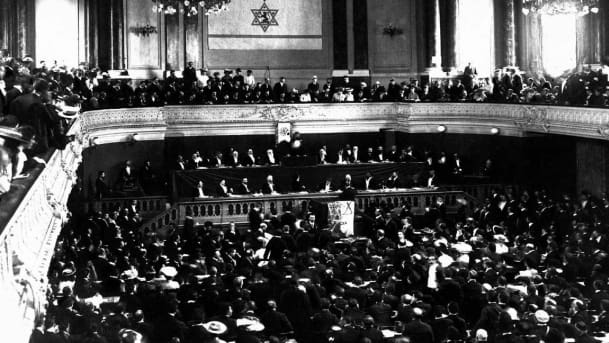
- 1897 — The First Zionist Congress meets, Zionism emerges as Jewish national movement; however, it is embraced by relatively few Jews worldwide. Small Jewish settlements already established in Palestine from 1870s forward. Some settlements fail. Some immigrant Jews reject their landlessness condition where they once lived; working and owning the land becomes central to a “new Jew.”
- 1901 — The Jewish National Fund is established to buy land and settle Jews in Palestine. Jewish numbers embracing Zionism are tiny.
- 1903-1905 — A wave of antisemitic riots hits Eastern Europe. These pogroms are reminiscent of previous governmentally sanctioned attacks against Jews.
- Early 1900s — The majority of the Arabs living in the area later to become Palestine are living subsistence agricultural lives; 90% of the area is rural, illiterate and impoverished. The rural population is living under enormous debt to other Arabs living in villages and towns. These small land-owing and urban elites and local sheiks drive local politics because they control the sparse cultivable land; by the end of World War I, a socio-economic hierarchy has evolved in Palestine, identical to what evolves in Lebanon, Syria, and Iraq. These small hierarchies take control of local politics under the French and British after the war; they assert legitimacy to rule locally by colonial officers in Paris and London. These local notables in Palestine and in neighboring Arab areas never genuinely seek self-determination for all, lest their own local power and influence be compromised. In the Palestine area, less than 5% of the population constitutes this well-to-do upper class.

- 1917 — The British-issued Balfour Declaration provides the Zionists with legitimacy to develop a national home in Palestine; they do so slowly, diligently, and undeterred. Arabs in Palestine are decidedly opposed to giving Jews any political privileges in Palestine.
- 1922 — League of Nations Mandates are trusteeships that Britain held after WWI over Iraq, Jordan and Palestine and France over Syria and Lebanon. The Balfour Declaration receives international legitimacy when in the preamble of the British Mandate for Palestine.
- 1937 — In response to prolonged violence between Arabs and Jews in Palestine, Britain suggests in its Peel Report that the area of Palestine be divided into two states, believing that friction between Jews and Arabs is too great from them to live together — the first suggestion of a two-state solution. Arabs reject the idea. Zionists continue to build small infrastructure for a state, linking immigrants to newly purchased land acquired from Arab sellers. Small Jewish economy develops with large foreign capital inflows aiding economic growth. American Jews do not show enthusiastic embrace of Zionism.
- 1939 — Dramatically, the British slow down the development of the Jewish National Home idea, appeasing Arab anger in surrounding Arab states at Jewish state building. The Mufti of Jerusalem on behalf of the Palestinian Arabs rejects British offer for a majority Arab state in Palestine in ten years. Arab leaders want no Jewish political presence in Palestine. By the outbreak of WWII, Jewish population of Palestine is more than 450,000. This represents more than 2/3 of total Jewish population that will be in the country when Israel is declared a state in 1948.
- 1939-1945 — Nazis in Europe kill 6 million Jews during WWII. No safe haven is granted to Jews seeking to be rescued; profound need for a Jewish state reaffirmed for Jews and particularly for the Zionists.
- 1945-1948 — Persistent U.S. State Department opposition to a Jewish state; Arab leaders vigorously reject Zionist offer for a two state solution in Palestine. ‘Azzam Pasha of the Arab League says only war will determine outcome of Zionist-Arab competition in Palestine, “even if Palestine is lost.”
- 1947 — The U.N. Partition Plan calls for establishment of separate Arab and Jewish states in Palestine, connected with an economic union; Jerusalem was to remain independently run by international community; Jews accept partition (e.g. a Jewish state). Arab and Muslim states reject two-state solution.
- 1948 — Israel’s Declaration of Independence as a Jewish state issued.
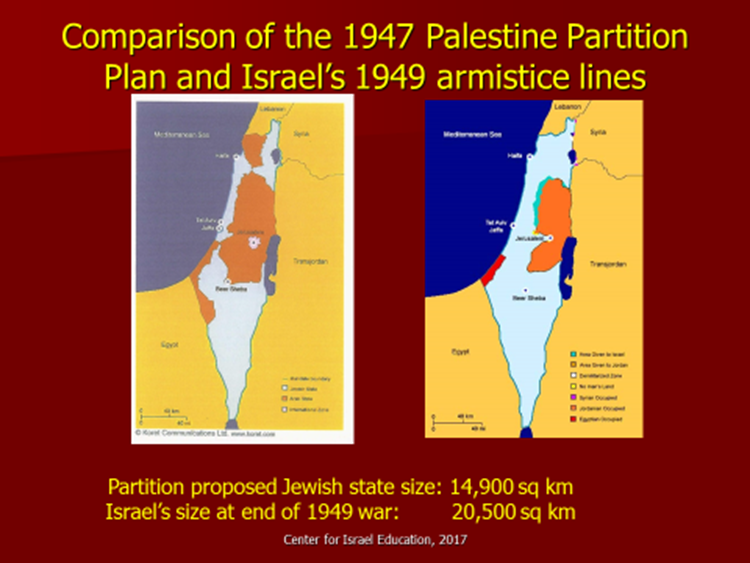

- 1948 — President Harry Truman recognizes Israel, although not with enthusiasm, since the U.S. State Department has opposed Israel as a Jewish state, fearing that Arabs will abandon U.S. friendship. The Soviet Union recognizes the Jewish state as way to hasten Britain’s departure from the Middle East.
- 1948-1949 War — Jewish state’s borders at end of war 37% larger than originally decided by UN in 1947; no Arab state in Palestine area is established, with Jordan taking most of the territory destined for Arab state; end of fighting results in continued “state of war” between Israel and Arab states, known as Armistice Agreements; no treaties signed. 730,000 Palestinians leave area that becomes Israel. Jerusalem becomes a divided city with Jordan and Israel each taking a portion.
- 1948-1952 — 800,000 Jews from Arab lands immigrate and settle in Israel, after undergoing significant duress at hands of many Arab leaders who believe all Jews are supportive of the new Zionist state. Jews in Israel’s Law of Return are given the right to come to Israel and become citizens. The organizational precursor of AIPAC, the American Israel Public Affairs Committee, is established. Jordan poised to sign an agreement with Israel in 1951, however, it is aborted when Jordanian King Abdullah is assassinated in Jerusalem. Both the Truman Doctrine and the Eisenhower Doctrine demonstrate American defense of the Middle East against the spread of communism and the USSR into the Middle East.
- 1950s-1970s — American Jews are not keen about Israeli leaders insisting that Jews should immigrate to Israel. US unsuccessfully seeks to slow down Israel’s nuclear quest. Israel suffers difficult economic times due to Arab boycott and strains caused by absorbing hundreds of thousands of Jewish refugees.
- 1956 — The Suez war is fought; Israel sweeps across Sinai in five days, with collusion but not physical assistance of France and Great Britain. Arab states believe that this Israeli success could not have come without British assistance.
- 1957 — Eisenhower cajoles Israeli withdrawal from Sinai while UN offers placement of international emergency force in Sinai to protect Israeli shipping rights. Secretary of State Dulles angry at Israel but also realizes Israel needs US protection with arms, and calls Israel a strategic asset as USSR influence in Middle East grows. Israel’s Ben-Gurion addresses Egyptian injustices of discrimination, hostility and boycott.
- Late 1950s — The U.S. begins to provide limited arms to Israel, in part because Arab states further align with the USSR; the U.S. is still uneasy about Israel’s quest for nuclear capacity.
- 1964 — The PLO is formed, outwardly seeking Israel’s destruction.
- 1967 — Arab states led by Egyptian President Nasser vigorously threaten Israel’s destruction; Israel preemptively strikes Arab states to gain military advantage, fearing for its survival; Israel expands size five-fold, taking control over East Jerusalem, the West Bank, the Gaza Strip, portions of the Syrian Golan Heights and all of the Egyptian Sinai Peninsula. U.N. Security Council Resolution 242 passes and becomes a framework for future Arab-Israeli negotiations; it calls for recognition of all states in the region and exchange of unspecified amount of territories which Israel took in the 1967 war. Israelis expand municipality of Jerusalem to encompass the Old City and some Arab neighborhoods, north, south and east of the areas Israel controlled before the 1967 War. No Arab-Israeli treaties are negotiated at the conclusion of the war.
- 1967 — After the war, Arab states unanimously agree at the Khartoum Summit conference, “no peace, no negotiation, no recognition” of Israel. First Jewish settlements established in the Golan Heights and near Hebron. Israel begins fifty years of divided outlooks about retaining the West Bank and other territories.
- 1969 — The American Rogers Plan with “withdrawal back to the 1967 lines” is the U.S. secretary of state’s suggestion. Israel is surprised by and rejects the public plan because Israel believes its interests are not represented. Israel wants to control its own destiny, borders and pace of negotiations with neighbors. Every Israeli prime minister dislikes foreign leaders deciding on Israel’s security policies.
- 1970 — Israel aids Jordan militarily when King Hussein’s regime is threatened by civil war and possible invasion from Syria.
- 1971-1973 — The United States becomes engaged in testing negotiation waters between Egypt and Israel, but the U.S. administration does not initiate negotiations, after secret meetings with Egyptian President Sadat’s adviser Hafez Ismail.
- 1973 — On Yom Kippur, Syria and Egypt attack Israel simultaneously. Egyptian President Anwar Sadat is interested in combining a limited military war along with diplomacy as means to liberate Sinai; Syria interested in destroying Israel. Cairo and Damascus see U.S. involvement differently. Egypt embraces Washington, not so Syria.
- 1973 — After suffering an initial setback, Israel beats back the surprise attack, with the assistance of U.S. military resupply. The war ends with Israel 40 kilometers from Damascus and 100 kilometers from Cairo. Israeli and Egyptian generals negotiate a disengagement agreement. Secretary of State Henry Kissinger achieves U.N. Security Council Resolution 338, which calls for direct negotiations between the parties, a keen desire of all previous Israeli governments. Kissinger choreographs the Geneva Middle East peace conference. It includes the Soviet Union, but the U.S. drives negotiations and excludes Europeans and the U.N. from mediation of disputes. Syria is livid at Egypt’s negotiations with Israel.
- 1974 — Henry Kissinger continues the mediation of Egyptian-Israeli differences, resulting in a January 1974 Military Disengagement between the countries, and persuades Syria to reach a Disengagement Agreement with Israel too. A five-month Arab oil embargo placed on the U.S. for supporting Israel during the 1973 war is removed.

- 1975 — U.S. President Gerald Ford halts arms transfers to Israel temporarily because Israel will not immediately withdraw farther from Sinai. The impasse is broken, and the United States mediates the Second (1975) Egyptian-Israeli agreement. Aid is restored. Significantly, the U.S. places its troops in Sinai as monitors separating Egyptian-Israeli military forces. Egypt moves to reopen the Suez Canal as sign of the return to normalcy. Israeli leadership under Yitzhak Rabin still remains highly skeptical of Egypt’s new President Sadat’s willingness to end war with Israel, though intermediaries from Romania and elsewhere suggest Sadat wants to change Egypt’s orientation away from Moscow and a failed socialist economy and to access American technology. To do all that Sadat understands that the U.S. will not abandon Israel, hence he seeks to harness American presidential engagement in some manner of diplomacy. Sadat is not initially pleased at Gerald Ford’s defeat but warms to Jimmy Carter’s engagement in seeking a comprehensive Middle East peace between Israel and her Arab neighbors.

- 1977 — U.S. President Jimmy Carter pushes Israel to accept negotiations with the PLO and withdraw from the West Bank and Gaza Strip in hopes of establishing a Palestinian State. Israeli Prime Ministers Rabin and Menachem Begin refuse to accept his conditions. Neither Israel nor Egypt are keen to go to an international conference where others will determine their negotiating positions; and neither want Carter’s preference to have the USSR engaged in Middle East negotiations. Sadat becomes impatient with Carter’s consumption with procedures; he and Begin have their emissaries meet away from US eyes. They prefer direct talks. Sadat goes to Jerusalem in November 1977 essentially diverting focus from Carter’s preferred comprehensive peace negotiating efforts. Sadat addresses the Israeli parliament. He stuns Arab world which still rejects any recognition or negotiations with Israel. Begin openly welcomes Sadat to Israel. Little progress is made in direct Israeli-Egyptian talks, causing US to engage both Egypt and Israel directly.
- 1977 — Israel-U.S. relations steadily sour as the Carter administration leans heavily toward support of the Saudi monarchy and continues the US embrace of Sadat shown already by the Nixon and Ford administrations. Going against the grain of Begin and all his predecessors, Carter insists in dictating what Israel’s security needs should be vis a vis the West Bank and Gaza Strip—Begin absolutely opposes the establishment of a Palestinian state in these areas, and opposes halting of Jewish settlements in these areas, which he considers integral to the Jewish patrimony.
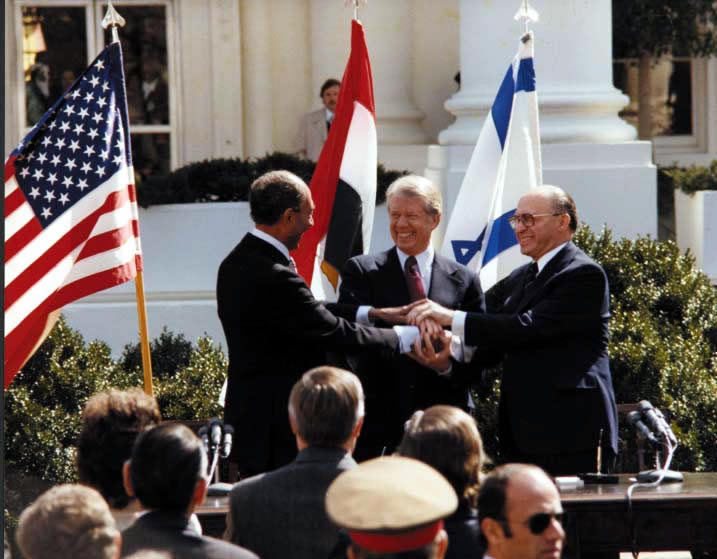
- 1978 — Camp David summit between Sadat, Begin, Carter and their aids results in Egypt and Israel signing two agreements, one for self-rule or autonomy for the Palestinians under Israeli control, and one an outline for an Egyptian-Israeli peace treaty. Continued negotiations for an E-I Treaty unfold slowly, with little progress made on implementing Palestinian self-rule. Israelis refuse to withdraw from the West Bank and Gaza Strip to provide land for a Palestinian entity or state. Carter administration greatly angered and frustrated by Begin government; yet Sadat and Carter see absolute priority in seeing an Egyptian-Israeli treaty negotiated and signed. Arafat refuses to join talks with the U.S.
- 1979 — The Egyptian-Israeli Peace Treaty is signed. Sadat is willing to sign a “separate peace” with Israel, leaving other Arab and Muslim states further angry at Sadat’s embrace of Israeli sovereignty; Shah of Iran leaves country due to unrest and illness; religious radical Islamic leader Khomeini returns to Iran; he powers Islamic political hegemony in Middle East and beyond. Israel and Egypt maintain a “cold peace,” though ambassadors are exchanged. Carter administration gladly casts a U.N. vote categorizing Israel as occupier of territories taken in June 1967 war.
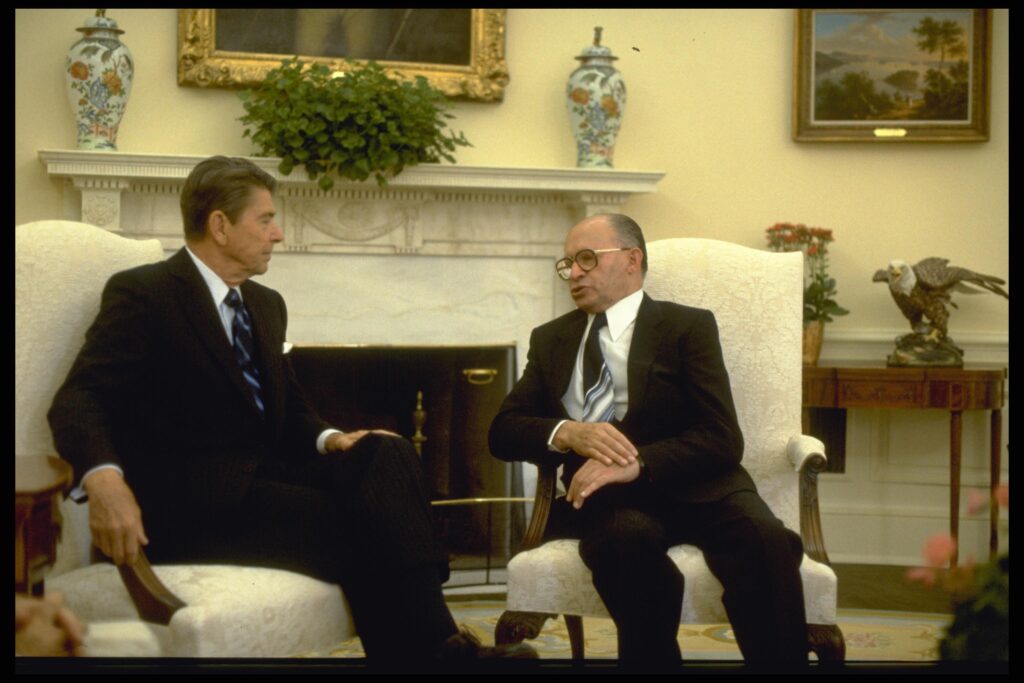
- 1980s — Reagan administration views Israel as strategic asset; Palestinian autonomy talks go nowhere, Israel builds settlements in West Bank and Gaza Strip, with the U.S. still opposed to settlement building. Europe offers its first ideas of negotiating an end to the conflict in the Venice Declaration.
- 1981 — The U.S. sells AWACS planes to Saudi Arabia despite loud Israeli protests. Israel withdraws from almost all of Sinai, per the treaty with Egypt. Reagan vilifies Israel for destroying the Iraqi nuclear reactor. Sadat is assassinated by Islamic militants; his successor, Hosni Mubarak, stays true to the treaty with Israel.
- 1982 — The Reagan Plan seeks to link the future of the West Bank with Jordan. Israel is surprised and miffed at not being consulted before the announcement. Again, Begin and Israel do not want to be told how to negotiate and what to concede in negotiations.

- 1982 — Israel invades southern Lebanon seeking to destroy PLO infrastructure there; Reagan admonishes Begin for moving Israeli troops into Beirut; American marines escort Arafat out of Beirut– PLO moves headquarters to Tunis.
- 1983 — The United States and Israel sign an agreement declaring Israel a strategic asset to the U.S. The U.S. assures Israel of a qualitative military edge in weapons supplies over its Arab neighbors.
- 1986-1995 — More than 1 million Russian Jews immigrate to Israel.
- 1987 — A major Palestinian uprising (intifada) against Israeli rule in territories unfolds to Israel’s surprise; it continues until 1992 with violence perpetrated against Israeli civilians–generating Israeli reprisals against Palestinians.

- 1988 — The U.S. opens dialogue with PLO without telling Israel, hoping to modify PLO’s reluctance to give up terrorism and non-Israeli recognition. PLO accepts UNSCR 242 and forswears terrorism. Hamas, the Palestinian militant Islamic organization issues its founding charter calling all land west of the Jordan River Muslim land, rejecting any acceptance of Zionism or the Jewish right to be a people in whatsoever. King Hussein politically disengages from the West Bank, leaving the PLO to fill the political vacuum; Hussein seeks to protect his East Bank territory, fearing that Palestinian WB violence will undermine Jordan’s future.
- 1989-1992 — U.S.-Israel relations grow distinctly cold over continuation of Israeli settlement building. Some Israeli historians publish books putting much of the blame of the dispersed Palestinian condition on Israeli behavior in 1947-49.

- 1991-1992 — During the first Bush administration, Iraq overruns Kuwait, with Iraqi President Saddam Hussein claiming he is also on the way to “liberate” Palestine. Iraq fires missiles at Saudi Arabia and Israel. Kuwait sovereignty is restored, Iraq is defeated, and Israel withholds military retaliation against Iraq. Israel curries favor with US for doing so. Madrid peace conference unfolds evolving into bilateral negotiations between Israel and each Arab neighbor, with Palestinians present in Jordanian delegation; multi-lateral talks on topical issues like water, refugees, borders, and economic development ensue between Israel and individual Arab states, and international community. No agreements are reached from the Madrid Peace Conference.
- 1992-1993 — Secret PLO-Israeli negotiations evolve, yielding the 1993 Oslo Accords, signed on the White House lawn. The PLO and Israel recognize each other. Israel provides the PLO with self-rule in the West Bank and Gaza Strip. Nothing is said about settlements; no Palestinian state is requested or promised. The Palestinian Authority (PA) is formed to govern the West Bank and Gaza. The PLO is not dissolved. Yasser Arafat remains the head of both Palestinian political organizations.

- 1994 — Jordan-Israel peace treaty is signed. The United States plays no significant role in its negotiation but provides Jordan with most-favored-nation trade status, which is the equivalent of some $4 billion to assist Jordan’s weak economy. Israel and Jordan reaffirm that sharing a geographic border requires them, even at odds on other matters, to implement military and intelligence cooperation to enhance each other’s strategic national interests.
- November 1995 — Israeli Prime Minister Yitzhak Rabin is assassinated by a right-wing-leaning Israeli disgruntled with Rabin’s signature on the Oslo Accords and possible provision of the West Bank (Judaea and Samaria) to Palestinian control.
- 1996-1999 — The Clinton-Netanyahu relationship is frosty; the expansion of Israeli settlements continues.
- 2000 — The August Camp David II summit unfolds, without pre-negotiations or tangible agreement results. PLO leader Arafat remains unready to accept Israel as a long-term neighbor. Israeli Prime Minister Ehud Barak’s proposals for a diplomatic agreement to end conflict are rejected.

- 2000 — Clinton tries to reopen Syrian-Israeli talks but does not succeed in moving Damascus and Jerusalem toward an agreement. The second major Palestinian intifada (uprising) erupts against Israeli civilians in the West Bank and inside pre-1967 Israel.
- 2000-2001 — Clinton leaves office after presenting Clinton Parameters as an outline for a negotiated settlement, no agreement is signed.
- 2001 — Israel initiates building the security “wall/fence” around pre-1967 borders, including many Jewish settlements built over the previous “green line” or armistice lines separating pre-1967 Israel from the West Bank; as consequence, over next decade and more, terrorist attacks against Israel largely reduced. Israel condemned by international community for building “fence/wall.” Fear exists from those abroad that the “fence/wall” will become de facto border between Israel and any Palestinian political entity. Active political delegitimization of Israel spawned through international meetings by progressives is joined by growth Arab and Islamic antisemitism.

- 2002 — U.S. President George W. Bush suggests a two-state solution to the Palestinian-Israeli conflict. U.N. Security Council Resolution 1397 affirms a two-state solution and is the first time the United Nations suggests a two-state solution since enacting partition.
- 2002 — Arab states call for qualified normalization of relations in the Arab Peace Initiative with Israel, but remain imprecise on resolution of Palestinian refugee issue; Israel will not accept Palestinian Arab return to Israel inside the pre-1967 lines fearing end of Jewish majority in state.
- 2003 — The Roadmap for a two-state solution is suggested by the Quartet: the European Union, the United Nations, the United States and Russia. It uses ambiguous language. Hamas rejects it out of hand. Israel accepts some of the terms suggested but has reservations because of no final resolution to the Palestinian refugee issue. Several EU countries show increased disfavor of Israel for continued settlement growth.

- 2004 — In an exchange of letters with Israeli Prime Minister Ariel Sharon, U.S. President George W. Bush affirms that Israel’s borders can be greater than the 1967 lines. Longtime PLO leader Yasser Arafat dies. Palestinian Arabs remain severely splintered ideologically on whether to negotiate with and recognize Israel. Hamas says no, never. Sharon publicly accepts the idea of a two-state solution to the conflict. The Palestinian Second Intifada slowly ends, but Palestinian attacks against Israel continue. Sharon amplifies his Gaza Disengagement Plan.
- 2005 — Israel unilaterally withdraws from the Gaza Strip, and four small settlements in the West Bank, hoping to ease toward normalization with PA and PLO; 9,000 Israeli settlers leave Gaza.
- 2006 — Hamas defeats Fatah in Palestine Legislative Council elections; corruption in Fatah leadership alienates many Palestinian voters.
- 2006 — Israel and Hezbollah engage in a 34-day war in Lebanon. No geographic changes result. Hezbollah rearms with weapons from Iran via Syria.

- 2007 — Hamas violently removes PLO/PA control over the Gaza Strip in a coup and militarizes the Strip, which is then used to launch rocket and infiltration attacks against Israel.
- 2007 — The Annapolis Peace Conference jump-starts Palestinian-Israeli negotiations but does not end the conflict. No agreements are signed. The Palestinians seek a permanent halt to all Israeli settlements.
- 2008-2009 — Israel-Hamas conflict erupts; Israel seeks to stop rocket attacks; Iran continues to build nuclear capacity to international and Israeli displeasure.
- 2009 — A settlement building controversy erupts anew between Israel and the United States. President Barack Obama says settlements should stop, while Prime Minister Benjamin Netanyahu in a Bar-Ilan University speech calls for a two-state solution, specifying a demilitarized Palestinian state.

- 2009 — The United Nations publishes a scathing report highly critical of Israel’s recent conflict with Hamas for targeting civilians, then author of report retracts conclusions as perhaps biased. European Parliament endorses support for Palestinian self-determination.
- 2010 — The United States renews its efforts at mediation. The United States affirms Israel’s right to be “a Jewish state.” Israel still seeks direct, bilateral, no-precondition talks with the Palestinians.
- 2010-2011 — In the Arab Awakening, otherwise known as the Arab Spring, Arab publics overthrow many authoritarian regimes, seeking better economic opportunities and end of political cronyism and corruption. Syrian civil war remains brutal into 2019. Egyptian, Libyan, Tunisian, and Yemeni leaders turned out of office. But authoritarian nature of most regimes in the Middle East and North Africa remain what they were for populations went to the streets. Sanctions against Iran’s building of nuclear capacity tightened. President Barack Obama calls for negotiations between Israelis and Palestinians based on the June 1967 war lines; Israel again is not pleased with a U.S. president defining what the negotiation outlines should be.
- 2012 — Israel again strikes at Hamas in Gaza for launching rockets into Israel. The violence ends after eight days of fighting. Hamas’ leader reaffirms the need for Israel’s disappearance.
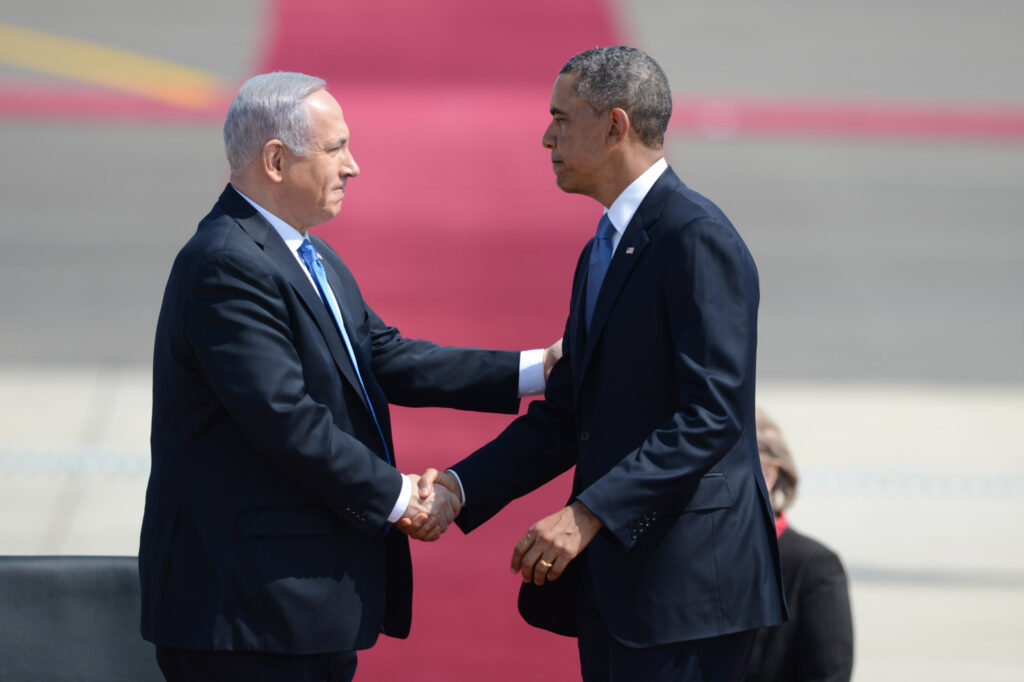
- 2012 — U.S. lawmakers create the Enhanced Security Cooperation Act, which President Obama signs into law, bringing the two states closer on military and strategic issues, all while the White House continues to staunchly oppose the building of Israeli settlements.
- 2013 — President Obama in Jerusalem appeals to the people of Israel to support negotiations based on a two-state solution.
- 2013 — Secretary of State John Kerry makes concerted effort to restart Palestinian-Israeli negotiations based on creating a process that would lead to a two-state solution, but by middle of 2014, his mediation efforts do not succeed.
- 2013-2014 — Hamas-Israel violence erupts.
- 2014 — The European Parliament calls for the recognition of Palestinian statehood in the context of a two-state solution.
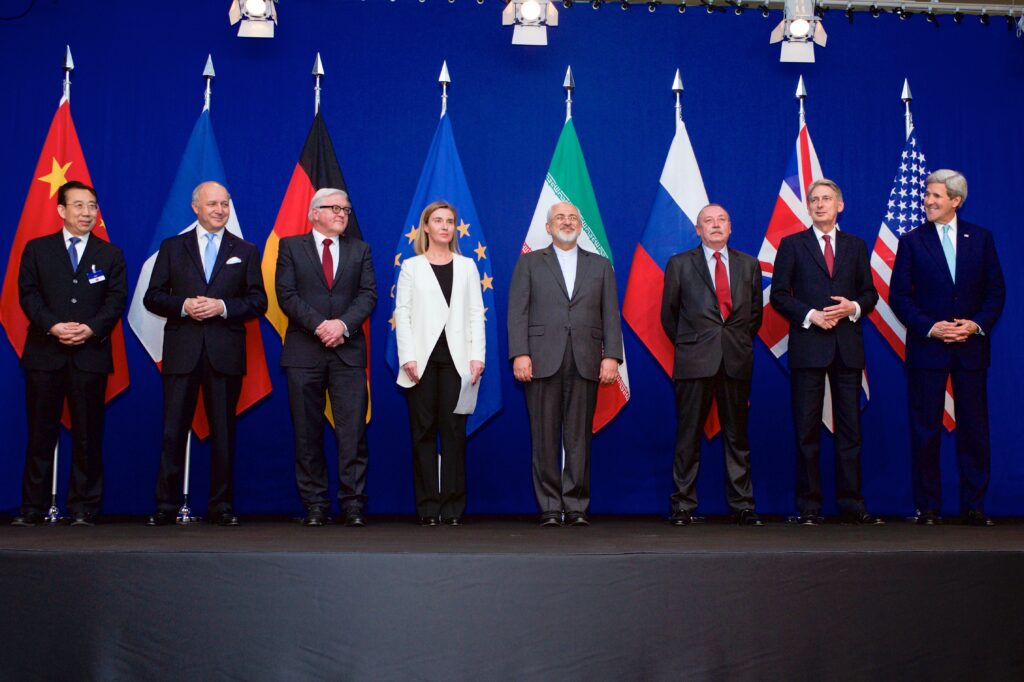
- 2014 — U.S. lawmakers pass the U.S.-Israel Strategic Partnership Act, which President Obama signs into law. Israel’s ambassador to the United Nations, Ron Prosor, chastises the U.N. for its hypocrisy.
- 2015 — The United States and five other countries sign an agreement with Iran to limit its nuclear development in exchange for relieving some sanctions. A major disagreement erupts between Israel and the United States over the agreement’s value. Controversy swirls about the Israeli Prime Minister Netanyahu’s address to Congress opposing the agreement with Iran.
- 2016 — The United States and Israel sign a 10-year memorandum of understanding to provide Israel with $38 billion in military aid over that span of time, but the Obama administration continues to chide Israel because of its settlement building. The U.N. Security Council passes Resolution 2334, which categorizes all the territories that Israel gained in the June 1967 war as occupied, including east Jerusalem, as topics for negotiation.

- 2017 — A Middle East conference in Paris emphasizes the need for a two-state solution. Prime Minister Netanyahu does not participate. President Donald Trump and Netanyahu meet in February, and Trump startles audience by saying, “One state or two states, whatever the Israelis and Palestinians want.” This is a break from the traditional U.S. advocacy of a two-state solution. In breaking international precedent, the United States officially recognizes Jerusalem as Israel’s capital.
- 2018 — Israeli parliament passes the 14th Basic Law, declaring Israel the nation-state of the Jewish people, emphasizing the Jewish nature of the state above other ethnic and religious groups. Israel warms relations with major Eastern European states and strengthens ties with India and Japan. Women in Israel challenge the denial of access to prayer at the Western Wall. Israel periodically attacks the threatening Iranian presence and capabilities in Syria.
- 2019 — Through proclamation, President Trump recognizes the Golan Heights as part of Israel, to the dismay of the international community. Israel’s population tops 9 million; 74% are Jewish, including 45% of world Jewry. Israel’s GDP is $353 billion, ranking 32nd in the world. By comparison, in 1948, 806,000 people lived in Israel, 80% of whom were Jewish, accounting for 6% of world Jewry. Israel holds April parliamentary elections, but the failure to construct a coalition of 61 members forces a second election in September.
- 2020 — After the third Israeli election in less than 18 months, Israelis form a coalition/unity government. President Trump announces his plan for a two-state solution to the conflict, including the option for Israel to annex West Bank lands. A major economic plan is associated with his proposal. The supportive funds to unfold a Palestinian state and support from other Arab states do not materialize. In August and September, through the good offices of the United States, the UAE and Bahrain recognize Israel diplomatically, on the explicit condition that Israel refrain from any annexation of West Bank lands. In October and December, respectively, Sudan and Morocco announce the normalization of relations with Israel. In all four cases, the United States provides each Arab country with a specific strategic, political or military objective. Israel announces plans for another parliamentary election in March 2021. Those elections result in Naftali Bennett from Yamina sworn as prime minister in June 2021, with Yesh Atid leader Yair Lapid taking the position of foreign minister. This coalition of eight parties is Israel’s 36th government; Bennett and Lapid agree to rotate their posts in August 2023. For the first time in Israel’s parliamentary history, an independent Arab party is part of the ruling coalition. Through 2021 and early 2022, Israel enhances its diplomatic status, with Bennett and Lapid visiting the UAE and Bahrain, and Israel’s new president, Isaac Herzog, warming ice-cold relations with a visit to Turkey in March 2022.
- May 2021 — Israel and Hamas fight their fourth war since 2008. The eleven-day confrontation begins when Hamas and Islamic Jihad unleash a barrage of rockets and mortars at Israel after Israel rejects their ultimatum to withdraw its security forces from the Temple Mount. In retaliation, Israel launches Operation Guardian of the Walls, an aerial bombing campaign, supported by artillery, targeting Hamas infrastructure and high-rises repurposed as command-and-control centers. In addition to the 4,300 projectiles that are fired at Israel (an average of 400 a day), Hamas deploys unmanned seacraft (“submarines”) primed to explode next to Israeli targets. In parallel to the confrontation between Israel and Hamas and Islamic Jihad, clashes erupt between Jews and Arabs in cities throughout Israel. This war with Hamas terminates as in the previous four clashes with Israel and Hamas engaged in a cease-fire where Hamas rearms itself preparing for the next round of fighting which suddenly take place in October 2023.
- November 2022 —Israelis go to the polls for the fifth time in less than four years. The following month, Israeli prime minister Benjamin Netanyahu forms Israel’s 37th government, comprising seven parties and the most right-wing Cabinet in Israeli history. Together with Likud, which has garnered the most seats, the coalition includes Shas, Otzma Yehudit, Noam, National Unity, the Religious Zionist Party and United Torah Judaism. This right-of-center government seeks to remove considerable power from the court system in Israel, under mass protest from Israeli civil society during the first half of 2023.
- October 7, 2023 — As dawn rises over Israel, the Gaza-based terrorist group Hamas launches the deadliest attack on the Jewish people since the Holocaust. The massacre, dubbed Operation al-Aqsa Flood, is an assault on Israel that unites Hamas’s three existential purposes: waging jihad (holy war), killing Jews, and undermining international support for Israel among nations of the world. After breaching the Gaza barrier and entering Israel under a hail of rockets, the terrorists spread out over a 30-mile zone surrounding Gaza, swarming dozens of civilian settlements and military installations. Then, they carry out their orders: “Kill as many people and take as many hostages as possible,” as per the instructions in a notebook later found on a terrorist’s corpse. With this barbarous objective in view, the assailants slaughter, without distinction, every living thing they encounter: Jews and Arabs, Israelis and foreigners, elderly and infants, men and women, civilians and soldiers, humans and dogs. The unspeakable brutality shocks the conscience of civilized humanity, and by day’s end, some 1,200 people lay dead in Israel with 240 in captivity in Gaza. Thus begins the fifth war between Israel and Hamas since 2008. U.S. President Joe Biden calls Hamas’ actions “evil,” warning Iran not to engage in this conflict; he dispatches American naval vessels to the Mediterranean and the Red Sea to deter the war from becoming a regional conflict. At the end of November the first hostage- Palestinian prisoner exchange is implemented; Hamas keeps as many hostages as possible to insure its political control over the on-going war. Additional hostage negotiations continue as does the war in Gaza, with Israel not willing to end its fight with Hamas until it is destroyed as a military and administrative force on Israel’s southern border.

- January 2024 — Almost exactly a year after the current government is sworn in, the Israeli Supreme Court issues two rulings that, together, take an axe to the central plank of Prime Minister Netanyahu’s political platform: limiting the power of the Israeli judiciary. In an 8-7 decision, the high court reinstates the “reasonableness clause” repealed by the Knesset in July 2023, restoring to the court the power to overturn government decisions it judges “unreasonable.” In a companion decision carried by an even larger majority (12-3), the court affirms its right to judicial review of Israel’s most important legislation, its 14 Basic Laws. Improbable though it may seem on the face of it, the judicial reform campaign that these two rulings have ended or, at the very least, suspended, does in fact relate to the war. In the months leading up to October 7, Israel’s military intelligence agency, Aman, sent four letters to the premier transmitting the same message: The social divisions created by the judicial overhaul were eroding Israeli deterrence. This warning was to prove well founded, as a captured Hamas commando told his Israeli interrogator, “We were encouraged by the demonstrations in Israel.”
- March 14, 2024 — In a highly unprecedented speech from the Senate floor, New York Senator Chuck Schumer enumerates four obstacles to reaching a resolution to the conflict: the presence of Israeli Prime Minister Netanyahu, Hamas and Palestinians who support their evil ways, radical-right wing Israelis in government and society, and PA leader Mahmoud Abbas.
- April 1, 2024 — Israel mounts airstrikes against the Iranian diplomatic compound in Damascus, killing seven, including the general responsible for Tehran’s operations in Syria and Lebanon. Mohammad Reza Zahedi was the most senior Iranian officer to be assassinated since January 2020, when Washington took out Qassem Soleimani, the leader of Iran’s Quds Force. Iran vows revenge against Israel.
- April 13-14, 2024 — In reprisal for Israel’s April 1 assassination of General Zahedi, Iran launches some 350 attack drones and cruise and ballistic missiles at Israel. This is Iran’s first ever direct Iranian attack against Israel since the Islamic Republic came into being in 1979. About 99% of the Iranian projectiles are intercepted by Israel’s multilayered defense system or shot down by Israel, with collaboration from Jordan, France, the U.K., the United States and others.
- April 19, 2024 — In retaliation for the Iranian attack a week earlier and under American pressure to avoid an escalation that could lead to all-out war, Israel carries out a limited airstrike in central Iran against the radar of Iran’s vaunted Russian-supplied S-300 air defense system. The precision strike was intended to signal to Iran that Israel can attack Iranian installations virtually at will.
- June 2024 — Israel Defense Forces rescue four Israeli hostages held by Hamas; Hezbollah in southern Lebanon notably increases daily rocket fire into northern Israel, with more than 60,000 Israelis still evacuated from their homes in northern Israel to central Israel.

- July 24, 2024 — To a joint session of Congress, Israeli Prime Minister Benjamin Netanyahu vows to achieve total victory over Hamas, a victory that will also be a triumph for the United States and a defeat for Iran. The 53-minute speech, repeatedly interrupted by bipartisan applause, mixes gratitude for U.S. support under Presidents Joe Biden and Donald Trump with an emphasis on the two countries’ shared interests as leading defenders of civilization and democracy against “barbarism” and “those who glorify death. Our enemies are your enemies, our fight is your fight, and our victory will be your victory.”
- July 24, 2024 — The Knesset votes overwhelmingly against the establishment of a Palestinian state. In the 120-member parliament, a 68-9 vote backs a resolution that says, “A Palestinian state would pose an existential danger to the State of Israel.”
- July 31, 2024 — Israel assassinates Ismail Haniyeh, the chairman of the Hamas Politburo and one of the organization’s most senior leaders, while he is on a state visit in Tehran. An explosive planted in the guesthouse for visiting dignitaries two months earlier is detonated remotely. His killing does not alter Hamas’ guerrilla warfare in the Gaza Strip.
- July-August 2024 — Israel military operatives kill numerous top Hamas commanders in the Gaza Strip, West Bank as well as Hezbollah leaders in Lebanon. For much of August, the region is on a knife’s edge, preparing for an Iranian/Hezbollah response to Israel, but a major confrontation does not unfold, with American, European and Arab leaders counselling restraint. The Hamas-Israel war winds on in Gaza.
- September 9, 2024 — In its largest sortie in Syria since the April 1 attack on an Iranian Consulate-adjacent building in Damascus that killed multiple Iranian Revolutionary Guard leaders, Israel strikes a military installation near Masyaf, in northern Syria, where chemical arms are reportedly manufactured and Iranian technicians housed.
- September 17 and 18, 2024 — Killing dozens and wounding thousands, an Israeli intelligence operation blows up thousands of pagers and handheld radios booby-trapped with explosives. Hezbollah had purchased the communications devices and distributed them to its members in the hope of avoiding Israeli tracking and targeting of cellphones. This Mossad operation culminates years of planning in multiple countries.
- September 27, 2024 — The IDF assassinates the leader of Hezbollah, Hassan Nasrallah. For 32 of Hezbollah’s 40 years, he led the group’s transformation from a band of guerrillas into a disciplined, highly equipped fighting force focused on Israel’s destruction. The assassination of Nasrallah is a major coup for Israel, as it goes a long way toward restoring Israeli deterrence and prestige eroded since Oct. 7, 2023. His killing, along with a dozen other Hezbollah commanders, severely dents the organization’s command and control, but those killings do not stop Hezbollah attacks against the Israeli population.
- September 29, 2024 — Dozens of Israeli aircraft carry out strikes against the Houthis at the Red Sea port city of Hodeidah in western Yemen. Israeli targets fuel installations, power plants and docks in retaliation for the Houthis’ unsuccessful ballistic missile attack against Israel the previous day.
- September 30, 2024 — After months of cross-border incursions, Israel initiates a limited ground invasion of Lebanon. The Israeli commandos are supported by air cover and artillery barrages from Israel. More than 1 million Lebanese flee northward, away from the fighting in the south and in Beirut. Hundreds of Hezbollah fighters and other Lebanese are killed or wounded. Israel’s objective is to free southern Lebanon of Hezbollah and remove its threats against northern Israel, so that some 65,000 Israelis can return to homes they evacuated in October 2023 when Hezbollah launched missile strikes to support Hamas’ attacks on southern Israel.
- October 1, 2024 — In reprisal for Israel’s assassination of the leaders of two of Iran’s most favored clients, Hamas’ Ismail Haniyeh and Hezbollah’s Hassan Nasrallah, Iran fires 181 ballistic missiles at Israel. Besides being the second-ever direct Iranian attack against Israel — the first was April 13 — the bombardment is the largest ballistic missile attack in history. Israel, the U.S. Navy and Jordan intercept all but several dozen missiles. An Israeli military base, a restaurant and a school are damaged, and a Palestinian is killed.
- October 3, 2024 — Less than a week after killing Hassan Nasrallah, Israel assassinates his presumptive successor as the head of Hezbollah, Hashem Safieddine. Nasrallah’s cousin, Safieddine led Hezbollah’s executive council, his official election as secretary-general just days away.
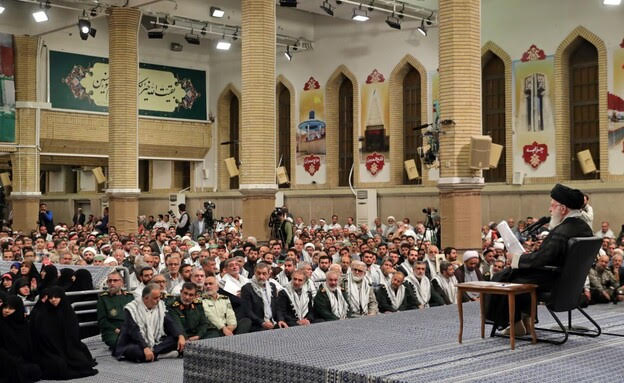
- October 4, 2024 — Iranian leader, Ayatollah Ali Kahamenei stipulates an unwavering commitment to destroying Israel, noting that Israel is the enemy of Egypt, Syria, Lebanon, Yemen and the Palestinians (he leaves out Jordan): “The Palestinians have the right to stand against the usurping Zionist regime.” Khamenei’s deep sense of loss for slain Hezbollah leader Hassan Nasrallah is manifold. Categorizing Israel as malicious, rootless and unstable, Khamenei says it has managed to stand on its feet with difficulty only with U.S. support. He says, “The primary cause of war, insecurity and backwardness in this region is the existence of the Zionist regime and the presence of governments that claim to seek peace and calm in the region. The main problem facing the Middle East region is foreign interference.”
- October 13, 2024 — A Hezbollah-launched drone strikes the Israeli Golani Brigade’s barracks outside Binyamina, 20 miles south of Haifa. Four soldiers are killed, and more than 60 are injured, several critically.
- October 16, 2024 — The IDF kills Hamas leader Yahya Sinwar. The mastermind of the Oct. 7 massacre, Sinwar had been the prime target of an Israeli manhunt ever since. For decades, he had been among the most virulent and uncompromising advocate for hating Israel and killing Jews. For example, Sinwar, quoted in al-Jazeera, said on May 26, 2021, “We support the eradication of Israel through armed Jihad and struggle. This is our doctrine. The occupation must be swept [away] from all our land,” expressing deep gratitude to Iran for providing Hamas with “money, weapons, and expertise.” The Israeli attack is praised in Israeli society, while Hamas presses on in its war with Israel. The immediate hopes of some hostage deal are quickly dashed.
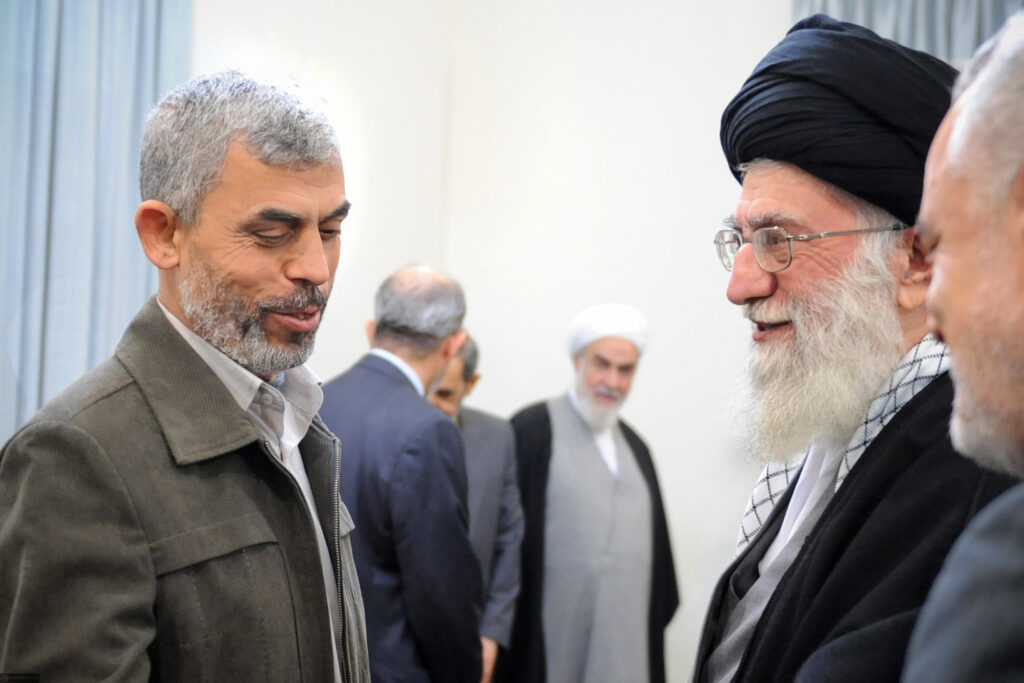
- October 26, 2024 — In a proportional response to Iran’s Oct. 1 missile attack, in a pre-dawn attack the Israeli Air Force dispatches more than 100 aircraft to Iran, striking multiple military facilities. Targets include military bases, air defense systems, missile production facilities and factories used to produce fuel for Iran’s long-distance missiles. The attack leaves the Iranian regime with virtually no air defenses against another Israeli attack, should it come. The Israelis do not target either Iran’s oil facilities or its nuclear weapons production capabilities. The U.S. government responds by warning Iran not to respond to this Israeli action. Israel’s attack occurs 10 days before the U.S. presidential election, with little comment from either major candidate. For Israel, it is the most complicated and most distant attack against an enemy in the state’s history. Iran promises a retaliation as Washington and other capitals seek to tamp down the prospects of a wider war in the Middle East.
- November 21, 2024 — The International Criminal Court, a tribunal that claims authority over all 124 of its member states, issues arrest warrants for Prime Minister Benjamin Netanyahu and former Defense Minister Yoav Gallant on charges of war crimes.
- November 27, 2024 — After nearly 14 months of war, a cease-fire between Israel and Hezbollah begins. The 13-point agreement between Israel and Lebanon (representing Hezbollah) calls for the evacuation of Israeli troops from Lebanon within 60 days and of Hezbollah terrorists south of Lebanon’s Litani River, which is 18 miles from the Israeli border. In Hezbollah’s place, 10,000 Lebanese soldiers are to deploy in “the Southern Litani Area.”
- December 8, 2024 — Syrian President Bashar al-Assad, in power since 2000, is overthrown, ending a dynasty that has ruled Syria for almost three-quarters of its modern history. Under the similarly autocratic rule of his father, Hafez al-Assad, from 1970 to 2000, Syria was among Israel’s most implacable regional enemies, its military having clashed with the IDF more than any other Arab army except Egypt’s. The Assad family considered Israel illegitimate. Consequently, it supported a network of Palestinian terrorist groups, including Hamas, and allied with Hezbollah to fight Israel through Israel’s Lebanese border. Ending Assad rule in Syria greatly diminishes Iranian influence in the country but does not guarantee that subsequent rulers and regimes will seek the kind of peace Israel has achieved with six other Arab countries. How and who pieces Syria together in the months and years ahead will determine whether a half-century of autocratic rule will be supplanted by tolerance for societal diversity.
- December 12, 2024 — Paraguay becomes the sixth country to relocate its embassy to Jerusalem, joining the United States, Guatemala, Honduras, Kosovo and Papua New Guinea.
- January 19, 2025 — In the first exchange of Israeli hostages for Palestinian prisoners under a new cease-fire agreement, three Israeli women return to Israel, and 90 Palestinian security prisoners are taken to the West Bank town of Betunia. Both sides celebrate the return of those held. But several Israeli government officials condemn the cease-fire deal and exchange, while others insist that nothing stands in the path of the return of the remaining 94 hostages, dead or alive, held by Hamas. The exchange fulfills the early part of the three phases of the cease-fire agreement; the first phase is scheduled to last 33 days. Enormous skepticism exists in Israel that the agreement will be fully implemented, whereby Hamas is to release all the hostages and the Hamas-Israel cease-fire is to continue indefinitely. The cease-fire terms include a large expansion of humanitarian supplies into Gaza.
- January 30, 2025 — Israel officially ceases cooperation with the U.N. Relief and Works Agency for Palestine Refugees under legislation passed by the Israeli parliament October 28, 2024. The Israeli government cites anger at UNRWA staff for being affiliated with Hamas and the attack of October 7, 2023.
- February 4, 2025 — President Donald Trump proposes relocating Gaza’s 2 million-plus Palestinians to other countries and transforming Gaza into the “Rivera of the Middle East” under U.S. ownership and control. Izzat al-Risheq, a senior member of Hamas’ political bureau, labels Trump’s proposal racist and a clear attempt to eliminate the Palestinian issue. Al-Risheq emphasizes that Palestinians are deeply rooted in their land and will not accept any plan to move them. Sami Abu Zuhri, another senior Hamas official, warns that such statements are a “recipe for chaos and regional tensions,” asserting that Gaza’s residents will not allow any such plan to be implemented. Other Arab states, including Saudi Arabia, Jordan and Egypt, reject Trump’s proposal out of hand. The Israeli reaction to the Trump idea for Gaza’s future is mixed, depending on current political outlooks and party identities.
- February 10, 2025 — Israel’s Channel 12 breaks a national scandal later dubbed “Qatargate.” The controversy centers on allegations Qatar paid several of Prime Minister Benjamin Netanyahu’s advisers, directly or through intermediaries, to mount an image-laundering campaign on Doha’s behalf. Under orders from Attorney General Gali Baharav-Miara some two weeks later, the Shin Bet and the Israel Police open an investigation, leading to the arrest of two senior advisers to the prime minister.
- February 12, 2025 — By the terms of the January 2025 cease-fire agreement, Hamas has released 33 hostages, including one American and five Thais, while Israel has freed nearly 2,000 Palestinians held in Israeli prisons for various reasons. Qatar, Egypt and the United States are engaged in sustaining the agreement.
- February 27, 2025 — The IDF releases the findings of its first internal probe into the military failures of October 7. The preliminary inquiry is a fact-finding probe only, the product of a months-long effort by the Southern Command, Operations Division, Israeli Air Force and Israeli Navy to understand what went wrong on Black Saturday.
- March 18, 2025 — One day shy of the two-month mark, the cease-fire between Israel and Hamas breaks down. Israel renews airstrikes after Hamas refuses either to release additional hostages or to extend the first phase of the agreement.
- March 21, 2025 — Prime Minister Benjamin Netanyahu’s Cabinet votes unanimously to dismiss Shin Bet chief Ronen Bar, citing a “loss of trust.” While the government insists that Bar is removed for his agency’s failure to forestall the October 7 attack, the opposition claims that the dismissal is politically motivated, a bid to sabotage the Shin Bet’s investigation into “Qatargate.” The Israeli Supreme Court issues an injunction freezing Bar’s firing. Bar eventually leaves his position.
- May 5, 2025 — Israel’s Security Cabinet approves an expanded battle plan to capture the whole Gaza Strip and push civilians southward.
- May 12, 2025 — In a U.S.-brokered stand-down, Hamas releases the last American hostage believed to be living, Israeli soldier Edan Alexander, after 19 months in Gaza captivity.
- May 13, 2025 — Israel announces it has killed Hamas leaders Mohammed Sinwar and Muhammad Shabana.
- May 15, 2025 — In Qatar after stopping in Saudi Arabia and before visiting the UAE, President Donald Trump pledges to defend Qatar, as he earlier pledged to defend Saudi Arabia.
- May 26, 2025 — An estimated 30,000 Jewish ultranationalists storm the Muslim Quarter in the Old City, chanting anti-Arab slogans and clashing with police and Palestinians.
- May 28, 2025 — Ten days after lifting an aid blockade, Israel implements a new distribution system for food and other aid in Gaza, taking control away from the United Nations and Hamas.
- May 29, 2025 — The White House says Israel has accepted a 60-day cease-fire proposal involving the release of 10 living hostages and 18 hostages’ bodies, freedom for more than 1,000 Palestinian convicts and detainees, humanitarian aid, and IDF redeployments. Hamas gives a cool response, reviews the package, then rejects it. Israel at the same time says it is prepared to attack Iran.
- June 13, 2025 — Israel pre-emptively attacks Iran to destroy, degrade or remove its nuclear enrichment program and the nuclear weaponization program, kill leading nuclear scientists and the regime’s military elite engaged in operations against Israel, neutralize the uranium enrichment facility in Natanz, and damage Iran’s ballistic missile infrastructure. Israel does not target Iran’s population. Iran retaliates with ballistic missile and drone attacks against Israeli cities. Prime Minister Netanyahu outlines Israel’s objectives in attacking Iran; they do not include regime change.
- June 21, 2025 — After offering Iranian leaders options to negotiate the end of their nuclear development program and being turned down, President Donald Trump deploys U.S. B-2 Spirit bombers carrying 30,000-pound deep-penetration munitions, as well as submarine-launched cruise missiles, to destroy three key locations in Iran’s nuclear weapons program.
- June 23-24, 2025 — Through the request of President Donald Trump, Iran and Israel agree to a cease-fire in their Twelve Day War. No details are announced about how, when and with what parameters the cease-fire will evolve into direct or indirect negotiations.
- July 28-30, 2025 — Israel announces a new military campaign against Gaza City, the last major city stronghold held by Hamas.
- July 29, 2025 — Led by France and Saudi Arabia, the U.N. offers one more political road map to halt the Hamas-Israel war and start negotiations. The New York Declaration calls for Palestinian Authority reform and two viable states living alongside each other in peace. Israel and the U.S. reject the declaration. (source)
- August 28, 2025 — The Israeli Air Force attacks the Houthis in Yemen after months of drone and missile fire aimed at Israel. The Israelis kill the head military commander, the Houthi prime minister and a dozen other officials. Israel has taken aim at other enemy leaders and Iranian operatives in Lebanon and Syria during the Hamas-Israel war and tries again but does not succeed in an attack on Hamas leaders in Doha on September 9, 2025. At the end of August, the humanitarian situation in Gaza has reached crisis proportions.
- September 9, 2025 — Israel launches airstrikes on Doha, the Qatari capital, targeting the highest Hamas leadership and killing several associates but not the intended individuals. Qatar decries the assault as “state terrorism.” President Trump says the strike does not advance Israeli or American goals. Secretary of State Marco Rubio visits Qatar to soothe the Qataris’ anger. The largest U.S. military base in the Middle East is in Qatar. On September 29, Trump issues a presidential order placing Qatar under the military protection of the U.S., something never offered to any other Arab country. (source)
- September 22, 2025 — In a U.N. General Assembly speech, French President Emmanuel Macron presents a Franco-Saudi outline for a two-state solution to the Palestinian-Israeli conflict. His speech is directly tied to the July 29, 2025, New York Declaration for a two-state solution and a September 12 U.N. General Assembly resolution supporting Palestinian statehood, approved on a 142-10 vote with 12 abstentions. Israel and the U.S. are among the opponents of the resolution. (source)
- September 29, 2025 — President Trump offers a comprehensive plan to end the Hamas-Israel war. This plan aims to achieve Israel’s war goals: the release of all hostages; the end of Hamas as a military and political force in the Gaza Strip; Gaza’s demilitarization; Israeli security control over the Strip; and a peaceful transition to a civilian government for Gaza under the auspices of an International Stabilization Force. (source)
- October 13, 2025 — Prime Minister Benjamin Netanyahu prefaces a long speech by President Trump at the Israeli parliament, praising him for his extraordinary friendship and stressing that Trump and his administration brokered the ceasefire with Hamas, with the 20 remaining living hostages returned to Israel in exchange for 2,000 Palestinian prisoners. Three days before the exchange, Israeli troops withdrew to control only 53% of the Gaza Strip. During the ceasefire, Hamas operatives begin summarily killing Gazans who oppose their rule, ostensibly for working with Israel. (source)
- October 13, 2025 — Dozens of Arab, European and other states meet in Sharm el-Sheikh, Egypt, to endorse President Donald Trump’s vision for an enduring peace in Gaza and the entire Middle East without much detail provided. Only the U.S., Qatar, Turkey and Egypt sign “The Trump Declaration for Enduring Peace and Prosperity,” which is not a treaty or a formal end to the two year war, but a declaration of general commitment to have a ceasefire.
- November 17, 2025 — The U.N. Security Council passes Resolution 2803, a U.S.-drafted text endorsing the 20-point Trump plan to end the Hamas-Israel war. It is the most detailed U.N. blueprint for resolving differences between Palestinian Arabs and Israeli Jews since the U.N. recommended partitioning Mandatory Palestine into Arab and Jewish states with an economic union in U.N. General Assembly Resolution 181 in November 1947. Resolution 2803 focuses on disarming Hamas, stabilizing the ceasefire, providing food and other humanitarian aid, reconstructing Gaza’s housing and other infrastructure, training a Palestinian technocratic administration, and maintaining security. In contrast to the 1947 resolution’s call for an Arab state (rejected by Palestinian Arab leaders and Arab neighbors), the 2025 plan essentially endorses a trusteeship over a small piece of the Arab state that could have been established under Resolution 181. Components of the trusteeship are to include the oversight of a Board of Peace, headed by President Donald Trump, and an International Stabilization Force (ISF) authorized through the end of 2027. The resolution does not name the states contributing to the force nor specify rules of engagement, whether arresting and disarming Hamas members or merely monitoring and reporting violations. The resolution cannot force any of the Palestinian factions or the Israeli government to give up long-term objectives. Hamas and other Palestinians want no Israel. And most Israelis do not want to cede any territory, lest their security be threatened as happened after the withdrawals from Lebanon in 2000, which saw Hezbollah evolve into a dominant military force on Israel’s northern border, and from Gaza in 2005, which saw Hamas seize control by mid-2007 and evolve a highly effective autocratic enclave that went to war with Israel five times from 2008 to 2025.

